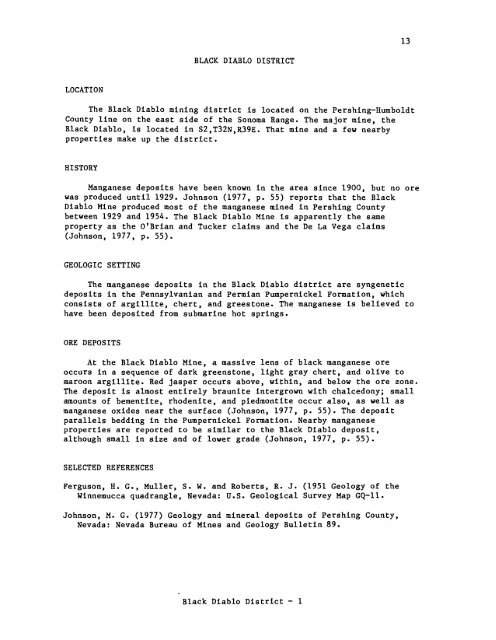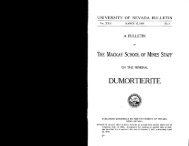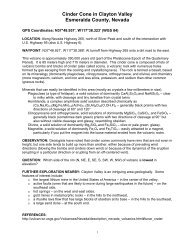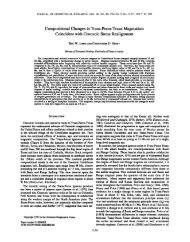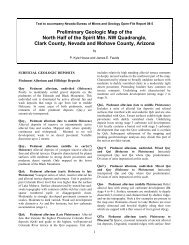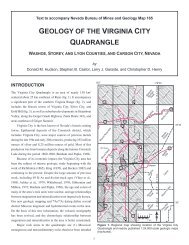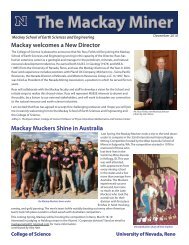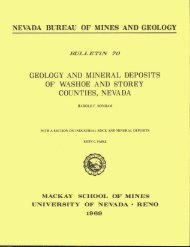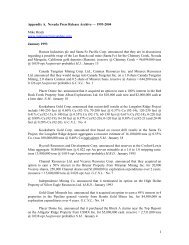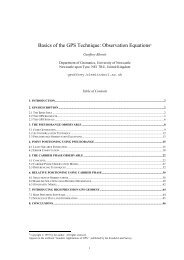- Page 1 and 2: UNIVERSITY OF NEVADA RENO NBMG OPEN
- Page 3 and 4: Summary of Work Performed Index Map
- Page 5 and 6: ) CRIB forms containing location an
- Page 7 and 8: - /-\- /- County Line SONOMA-GER LA
- Page 9 and 10: ORE DEPOSITS At the Nevada-Superior
- Page 11 and 12: LOCATION ANTELOPE SPRINGS DISTRICT
- Page 13 and 14: LOCATION ARABIA DISTRICT The Arabia
- Page 15 and 16: LOCATION AWAKENING DISTRICT The Awa
- Page 17 and 18: Johnson, M. G. (1973) Placer gold d
- Page 19: ORE DEPOSITS The lode deposits at t
- Page 23 and 24: (Bailey and Phoenix, 1944), and flu
- Page 25 and 26: ORE DEPOSITS Only two areas of mine
- Page 27 and 28: LOCATION BOTTLE CREEK DISTRICT The
- Page 29 and 30: the sheared rhyolite. Workings are
- Page 31 and 32: quartz monzonite intrude the Havall
- Page 33 and 34: Something less than 1/2 mile south-
- Page 35 and 36: LOCATION DEEPHOLE DISTRICT The Deep
- Page 37 and 38: adit driven into the pendant(?). If
- Page 39 and 40: GEOCHEMICAL RELATIONSHIPS Gold was
- Page 41 and 42: displacement in excess of 2,000 fee
- Page 43 and 44: LOCATION DONNELLY DISTRICT The Donn
- Page 45 and 46: LOCATION DUTCH FLAT DISTRICT For th
- Page 47 and 48: SELECTED REFERENCES Bailey, E. H. a
- Page 49 and 50: ORE DEPOSITS Most of the mineraliza
- Page 51 and 52: shale with lesser carbonaceous lime
- Page 53 and 54: Crone, W. R. (1982) The use of Fe/M
- Page 55 and 56: mercury mines are of the opalite ty
- Page 57 and 58: LOCATION GOLD RUN DISTRICT The Gold
- Page 59 and 60: SELECTED REFERENCES Couch, B. F. an
- Page 61 and 62: At the Gayer-Moo property, very spa
- Page 63 and 64: Mineralization in the district appe
- Page 65 and 66: and dip steeply to the vest. .... A
- Page 67 and 68: LOCATION IMLAY DISTRICT The Imlay d
- Page 69 and 70: apparently did not contain cinnabar
- Page 71 and 72:
LOCATION INDIAN DISTRICT The Indian
- Page 73 and 74:
LOCATION IRON HAT DISTRICT The Iron
- Page 75 and 76:
Southern Pacific Co. (1964) Mineral
- Page 77 and 78:
silver per ton and a trace gold. Ho
- Page 79 and 80:
LOCATION JACKSON MOUNTAINS DISTRICT
- Page 81 and 82:
SELECTED REFERENCES Lincoln, F. C.
- Page 83 and 84:
of manganese oxides occur in rocks
- Page 85 and 86:
andesitic volcanic rocks that have
- Page 87 and 88:
LOCATION JUNCO AREA For the purpose
- Page 89 and 90:
LOCATION JUNIPER RANGE DISTRICT The
- Page 91 and 92:
LOCATION KENNEDY DISTRICT The Kenne
- Page 93 and 94:
Borlaasca Mines are along the main
- Page 95 and 96:
LOCATION LkKE DISTRICT The Lake dis
- Page 97 and 98:
Willden, R., and Speed, R. C. (1974
- Page 99 and 100:
Northwest of Leadville, approximate
- Page 101 and 102:
LOCATION LEONARD CREEK DISTRICT The
- Page 103 and 104:
from 3.8 to 140 ppm gold. Silver va
- Page 105 and 106:
ORE DEPOSITS The mineral deposits a
- Page 107 and 108:
LOCATION MILL CITY (CENTRAL) MINING
- Page 109 and 110:
present, and all samples showed det
- Page 111 and 112:
GEOCHEMISTRY In addition to iron th
- Page 113 and 114:
ORE DEPOSITS The mercury deposits a
- Page 115 and 116:
Papke, K. G. (1979) Fluorspar in Ne
- Page 117 and 118:
SELECTED REFERENCES Johnson, M. G.
- Page 119 and 120:
minor amounts of tremolite, pyrrhot
- Page 121 and 122:
LOCATION OPALITE (CORDERO) DISTRICT
- Page 123 and 124:
McKee, E. 8. (1976) Origin of the M
- Page 125 and 126:
LOCATION POTOSI MINING DISTRICT The
- Page 127 and 128:
has been mined from two localities
- Page 129 and 130:
LOCATION POVERTY PEAK DISTRICT The
- Page 131 and 132:
In 1954 Sonoma Mines, Inc. acquired
- Page 133 and 134:
LOCATION RABBIT HOLE DISTRICT The R
- Page 135 and 136:
LOCATION RAGGED TOP DISTRICT The Ra
- Page 137 and 138:
Vanderburg, W. 0. (1936) Reconnaiss
- Page 139 and 140:
quartz is commonly crushed and occu
- Page 141 and 142:
In the south-southwest portion of t
- Page 143 and 144:
district, the silver-bearing quartz
- Page 145 and 146:
LOCATION ROSEBUD DISTRICT The Roseb
- Page 147 and 148:
LOCATION ROSE CREEK DISTRICT The Ro
- Page 149 and 150:
LOCATION RYE PATCH DISTRICT The Rye
- Page 151 and 152:
LOCATION SAN EMIDIO DESERT - LAKE R
- Page 153 and 154:
"cabin" a few hundred feet. It tren
- Page 155 and 156:
SELECTED REFERENCES Johnson, M. G.
- Page 157 and 158:
LOCATION SCOSSA DISTRICT The Scossa
- Page 159 and 160:
LOCATION SEVEN TROUGHS DISTRICT The
- Page 161 and 162:
tin, and one contained high molybde
- Page 163 and 164:
SELECTED WFERENCES Stager, H. K. (i
- Page 165 and 166:
LOCATION SIERRA DISTRICT The Sierra
- Page 167 and 168:
Jones, R. B. (1984) Directory of Ne
- Page 169 and 170:
of the old Spring City tovnsite. Th
- Page 171 and 172:
LOCATION SPRING VALLEY DISTRICT The
- Page 173 and 174:
LOCATION STAGGS DISTRICT The Staggs
- Page 175 and 176:
LOCATION STAR DISTRICT The Star dis
- Page 177 and 178:
SELECTED REFERENCES Johnson, M. G.
- Page 179 and 180:
of Tertiary sedimentary rocks, alth
- Page 181 and 182:
LOCATION TABLE MOUNTAIN DISTRICT Th
- Page 183 and 184:
There are two fluorspar properties
- Page 185 and 186:
Wallace, R. E., Silberling, N. J.,
- Page 187 and 188:
thrust fault separates two of these
- Page 189 and 190:
LOCATION TOBIN ANTI SONOMA RANGE MI
- Page 191 and 192:
SELECTED REFERENCES Bailey, E. H.,
- Page 193 and 194:
ORE DEPOSITS The tungsten deposits
- Page 195 and 196:
LOCATION TREGO HOT SPRINGS AREA The
- Page 197 and 198:
SELECTED REFERENCES Kerr, P. F. (19
- Page 243 and 244:
APPENDIX A
- Page 245 and 246:
Sample Number 492 495 Sample Descri
- Page 247 and 248:
Sample Number Location Sample Descr
- Page 249 and 250:
Sample Number 1490 Location Sample
- Page 251 and 252:
Sample Number Location Quad: Sulphu
- Page 253 and 254:
Sample Description Sample Number Lo
- Page 255 and 256:
Sample Number 2258 I Sample Descrip
- Page 257 and 258:
Sample Number Sample Description Se
- Page 259 and 260:
Sample Number 2319 2320 2321 2322 2
- Page 261 and 262:
Sample Number 2337 2340 2341 2342 2
- Page 263 and 264:
Sample Number 2358 2359 I I Quad Ad
- Page 265 and 266:
Sample Number Lccation Sample Descr
- Page 267 and 268:
Sample Number Location Sample Descr
- Page 269 and 270:
Sample Number 2411 I UTM Sample Des
- Page 271 and 272:
Sample Number quad: p~ Location Don
- Page 273 and 274:
Sample Number Sample Description Qu
- Page 275 and 276:
Sample Number Location Sample Descr
- Page 277 and 278:
Sample Description Sample Number 1
- Page 279 and 280:
Sample Number sac 2 - 31N -. R -~ 3
- Page 281 and 282:
Sample Number 2554 2558 2559 25hn Q
- Page 283 and 284:
Sample Number 2572 Location . Sampl
- Page 285 and 286:
Sample Number 2589 25!xL-. I Locati
- Page 287 and 288:
Sample Description Sample Number Lo
- Page 289 and 290:
Sample Number Location Quad: Sec: S
- Page 291 and 292:
Sample Number Location Sample Descr
- Page 293 and 294:
- aJ c U .r( -d aJ L > aJ Y -4-4 M
- Page 295 and 296:
Sample Number 2h70 2672 Location Sa
- Page 297 and 298:
Sample Number Location auaa: L_ovel
- Page 299 and 300:
Sample Number 2719 L/ZO 2721 I uTM
- Page 301 and 302:
Sample Number Location I 2801 I Qua
- Page 303 and 304:
Sample Number 2824 2827 Location cu
- Page 305 and 306:
Sample Number Location Sample Descr
- Page 307 and 308:
Sample Number Location Sample Descr
- Page 309 and 310:
Sample Number Location Quad 3-aes t
- Page 311 and 312:
Sample Number Location Sample Descr
- Page 313 and 314:
Sample Number 2904 2905 I Sample De
- Page 315 and 316:
Sample Number Location Quad: Fox Ru
- Page 317 and 318:
Sample Number 2937 2939 --z%42- Loc
- Page 319 and 320:
Sample Number 2951 Location Sample
- Page 321 and 322:
Sample Number 2966 2967 Location Qu
- Page 323 and 324:
Sample Number 2982 1 aul Railroad P
- Page 325 and 326:
Sample Description I I Sample Numbe
- Page 327 and 328:
Element Semi-Quantitative Spectrogr
- Page 329 and 330:
Element Semi-Quantitative Spectrogr
- Page 331 and 332:
Element Fe % (.05) Mg % (.02) Ca %
- Page 333 and 334:
- , Semi-Quantitative Spectrographi
- Page 335 and 336:
1 ' I Element Fe % ( 05) Mg % ( 02)
- Page 337 and 338:
Element Fe % ( 05) Mg % ( 02) Ca %
- Page 339 and 340:
. Semi-Quantitative Spectrographic
- Page 341 and 342:
ilement r05) "' rO2) ca "5) Ti b02)
- Page 343 and 344:
, Semi-Quantitative Spectrographic
- Page 345 and 346:
Element Fe % (.05) Mg % (.02) Ca %
- Page 347 and 348:
! Element Fe % (.05) Mg % (.02) - C
- Page 349 and 350:
Semi-Quantitative Spectrographic An
- Page 351 and 352:
'"05) " "2) 'a r05) Ti i!O02) hl n
- Page 353 and 354:
- Semi-Quantitative Spectrographic
- Page 355 and 356:
. Semi-Quantitative Spectrographic
- Page 357 and 358:
Element Sr (100) i v 1 (1 01 W (50)


